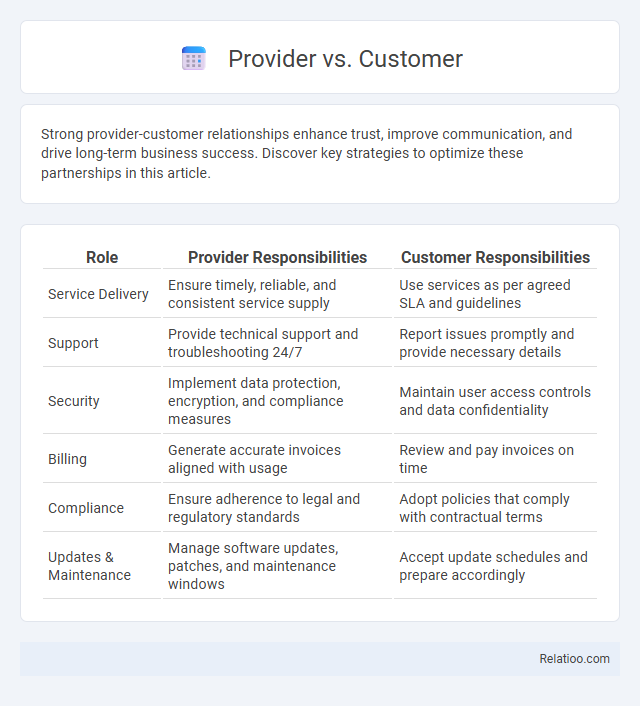Strong provider-customer relationships enhance trust, improve communication, and drive long-term business success. Discover key strategies to optimize these partnerships in this article.
Table of Comparison
| Role | Provider Responsibilities | Customer Responsibilities |
|---|---|---|
| Service Delivery | Ensure timely, reliable, and consistent service supply | Use services as per agreed SLA and guidelines |
| Support | Provide technical support and troubleshooting 24/7 | Report issues promptly and provide necessary details |
| Security | Implement data protection, encryption, and compliance measures | Maintain user access controls and data confidentiality |
| Billing | Generate accurate invoices aligned with usage | Review and pay invoices on time |
| Compliance | Ensure adherence to legal and regulatory standards | Adopt policies that comply with contractual terms |
| Updates & Maintenance | Manage software updates, patches, and maintenance windows | Accept update schedules and prepare accordingly |
Introduction to Provider vs Customer
A provider delivers goods or services to fulfill the needs of a customer, establishing a supply-demand relationship fundamental in business transactions. Customers seek and purchase offerings based on their preferences and requirements, driving market demand. The dynamics between provider and customer shape product development, service quality, and overall market competition.
Defining the Provider Role
The provider role involves delivering goods or services to customers, ensuring quality, reliability, and compliance with industry standards. Providers manage resources, coordinate supply chains, and maintain communication to meet customer demands efficiently. Understanding the provider role is essential for optimizing service delivery and fostering long-term business relationships.
Understanding the Customer Perspective
Understanding the customer perspective is essential for providers to deliver tailored solutions that meet specific needs and expectations. By analyzing customer behavior, preferences, and pain points, you can improve service quality and foster stronger relationships. This customer-centric approach enhances satisfaction and drives long-term loyalty in provider-customer interactions.
Key Differences Between Providers and Customers
Providers offer goods or services, bearing responsibility for quality, delivery, and support, while customers seek to fulfill needs or solve problems by purchasing or using those offerings. Providers drive value creation through supply chain management, innovation, and service excellence, whereas customers focus on value extraction, satisfaction, and feedback based on their experiences. The key differences lie in their roles within the transaction--providers act as creators and facilitators, customers function as consumers and evaluators.
Expectations on Both Sides
Expectations between provider and customer revolve around clear communication, quality service delivery, and timely problem resolution. Providers must ensure transparency, reliability, and proactive support, while customers are expected to provide accurate requirements and timely feedback. Your satisfaction depends on both parties meeting these mutual obligations to foster trust and successful collaboration.
Communication in Provider-Customer Relationships
Effective communication in provider-customer relationships drives satisfaction, loyalty, and trust. Providers must prioritize clarity, responsiveness, and active listening to address customer needs and concerns accurately. Leveraging digital communication tools enhances real-time interaction, ensures transparency, and fosters stronger provider-customer connections.
Challenges Faced by Providers and Customers
Providers face challenges such as managing service quality, ensuring timely delivery, and maintaining scalable infrastructure to meet customer demands. Customers struggle with clarity in communication, accessing consistent support, and navigating complex service terms that affect satisfaction. Your experience depends heavily on overcoming these issues through effective collaboration and transparency between providers and customers.
Best Practices for Effective Collaboration
Establishing clear communication channels and setting mutual expectations are essential best practices for effective collaboration between providers and customers. Implementing regular feedback loops enhances transparency and helps identify issues early, fostering trust and continuous improvement. Leveraging collaborative tools and aligning goals ensure streamlined workflows and increased project success rates.
Impact of Technology on Provider-Customer Dynamics
Technology has revolutionized Provider-Customer dynamics by enabling real-time communication, personalized experiences, and data-driven decision-making. Providers leverage AI and automation to enhance service efficiency and anticipate customer needs, while customers benefit from greater access to information and self-service options. Emerging technologies like blockchain ensure transparency and trust, reshaping traditional roles and fostering more collaborative interactions.
Future Trends in Provider-Customer Interactions
Future trends in provider-customer interactions emphasize seamless integration of AI-driven communication and personalized experiences, transforming traditional service models. Providers leverage advanced data analytics and real-time feedback mechanisms to anticipate customer needs and enhance satisfaction. The rise of omnichannel platforms and automated support systems enables more efficient, responsive, and scalable engagement between providers and customers.

Infographic: Provider vs Customer
 relatioo.com
relatioo.com